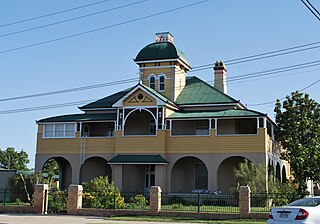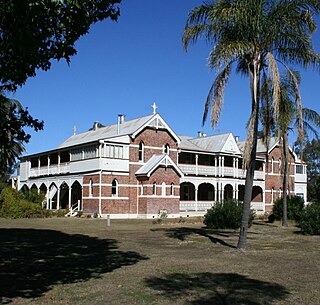
A window is an opening in a wall, door, roof, or vehicle that allows the exchange of light and may also allow the passage of sound and sometimes air. Modern windows are usually glazed or covered in some other transparent or translucent material, a sash set in a frame in the opening; the sash and frame are also referred to as a window. Many glazed windows may be opened, to allow ventilation, or closed, to exclude inclement weather. Windows may have a latch or similar mechanism to lock the window shut or to hold it open by various amounts.

St. Luke's Church, also known as Old Brick Church, or Newport Parish Church, is a historic church building, located in the unincorporated community of Benns Church, near Smithfield in Isle of Wight County, Virginia, United States. It is the oldest church in Virginia and oldest church in British North America of brick construction. According to local tradition the structure was built in 1632, but other evidence points to a date of 1682; see Dating controversy.

St Michael's Church is in St Michael's Road, Ditton, Widnes, Halton, Cheshire, England. It is recorded in the National Heritage List for England as a designated Grade II* listed building. It is an active Roman Catholic church.
Korona, Florida is an unincorporated community in Flagler County, Florida, United States. It is located north northeast of Favoretta on US 1, at the shared intersection of CRs 2002 and 325, south of Bunnell. The community is part of the Deltona–Daytona Beach–Ormond Beach, FL metropolitan statistical area.

The Church of All Saints is a parish of the Catholic Church in the Diocese of Davenport. The church is located in Keokuk, Iowa, United States. The church building is listed on the National Register of Historic Places as St. Peter Church, the name of the congregation that built it.

St. Mary's Catholic Church, known as the "Prairie Cathedral" or the "Cathedral of the Cornfields", is a Roman Catholic church in Beaverville, Illinois. The Romanesque Revival church was built in 1909–1911. The church features two towers and a tiled dome roof; it is both the tallest and most prominent landmark in Beaverville. In 1996, the church was added to the National Register of Historic Places.

St. Paul's Episcopal Church is a historic parish of the Episcopal Church in Watertown, Wisconsin,. Its buildings display different phases of Gothic Revival architecture, and in 1979 the complex was added to the National Register of Historic Places for its architectural significance.

The second St Mary's Roman Catholic Church is a heritage-listed sandstone Catholic church at 163 Palmerin Street in Warwick in the Southern Downs Region, Queensland, Australia. It was designed by Dornbusch & Connolly and built from 1920 to 1926. It is also known as St Mary of the Assumption Church. It was added to the Queensland Heritage Register on 21 October 1992.

Saint Leonard Catholic Church is a Roman Catholic church in the city of Madison, in the state of Nebraska in the Midwestern United States. Built in 1913, it has been described as "an outstanding example of the Romanesque Revival style of architecture."

The House of Tomorrow is an Art Deco style house that was built in 1937 in the Guilford neighborhood of Baltimore, Maryland.

The St. Joseph's Church Complex is a collection of historic buildings located in Fort Madison, Iowa, United States. At one time the complex housed a Catholic parish in the Diocese of Davenport. St. Joseph and St. Mary of the Assumption parishes merged in the 1990s to form Saints Mary and Joseph Parish. In 2007 when that parish merged with Sacred Heart on the west side to form Holy Family Parish, St. Joseph's Church was closed. The former church, chapel, rectory, convent, and school were included as contributing properties in the Park-to-Park Residential Historic District that was listed on the National Register of Historic Places in 2014.

Our Lady of Assumption Convent is a heritage-listed former Roman Catholic convent at 8 Locke Street, Warwick, Southern Downs Region, Queensland, Australia. It was designed by Simkin & Ibler and built from 1891 to 1914. It is also known as Assumption College, Cloisters, and Sophia College. It was added to the Queensland Heritage Register on 21 October 1992.

St Mary's Presbytery is a heritage-listed Roman Catholic presbytery of St Mary's Roman Catholic Church at 142 Palmerin Street, Warwick, Southern Downs Region, Queensland, Australia. It was designed by Wallace & Gibson and built from 1885 to 1887 by John McCulloch. It is also known as Father JJ Horan's private residence. It was added to the Queensland Heritage Register on 31 July 2008.

The Pinhook Methodist Church and Cemetery are located in New Durham Township, LaPorte County, Indiana at Wozniak Road with State Road 2. Known as the village of Pinhook, formerly New Durham. The village is mostly residential along the south side of State Road 2. The site includes the Pinhook Methodist Church (1847), the Pinhook Cemetery (1850), the cemetery storage shed, and the old pump.

North Chatham Historic District is a historic district consisting of most or all of the hamlet of North Chatham in Columbia County, New York. It was listed on the National Register of Historic Places in 2023.

St James Catholic Church is a heritage-listed Roman Catholic church located in Monash Avenue, Malanda, Tablelands Region, Queensland, Australia. It was designed by Bob Hassall, built by Alby Halfpapp in late 1926, and was opened on 23 January 1927. It was added to the Queensland Heritage Register on 28 July 2000.

St Columba's Convent is a heritage-listed Roman Catholic former convent at 169 Cunningham Street, Dalby, Western Downs Region, Queensland, Australia. It was designed by George Bernard Roskell and built in 1913 by John Draney. It is also known as Iona. It was added to the Queensland Heritage Register on 9 December 2010.

Furnaceland is a townland in the civil parish of Kinawley, barony of Tullyhaw, County Cavan, Ireland. The original Irish place name was Maghernavinagh, which in Gaelic was either Machaire Eanach, meaning "The Plain of the Marsh" or Machaire Mhianach, meaning "The Plain of the Mine"). The town of Swanlinbar is partially situated in Furnaceland.

The Espanola Schoolhouse is a one-story; one-room rural school building that has survived from the Jim Crow racial segregation-era. It is the last standing one-room schoolhouse in Flagler County. It is located at 98 Knox Jones Avenue, Bunnell, Florida 32110.

St. Mary of the Assumption Church is a parish of the Roman Catholic Church located at Laurin, Madison County, Montana, United States, in the Diocese of Helena. It is noted for its historic parish church.

































